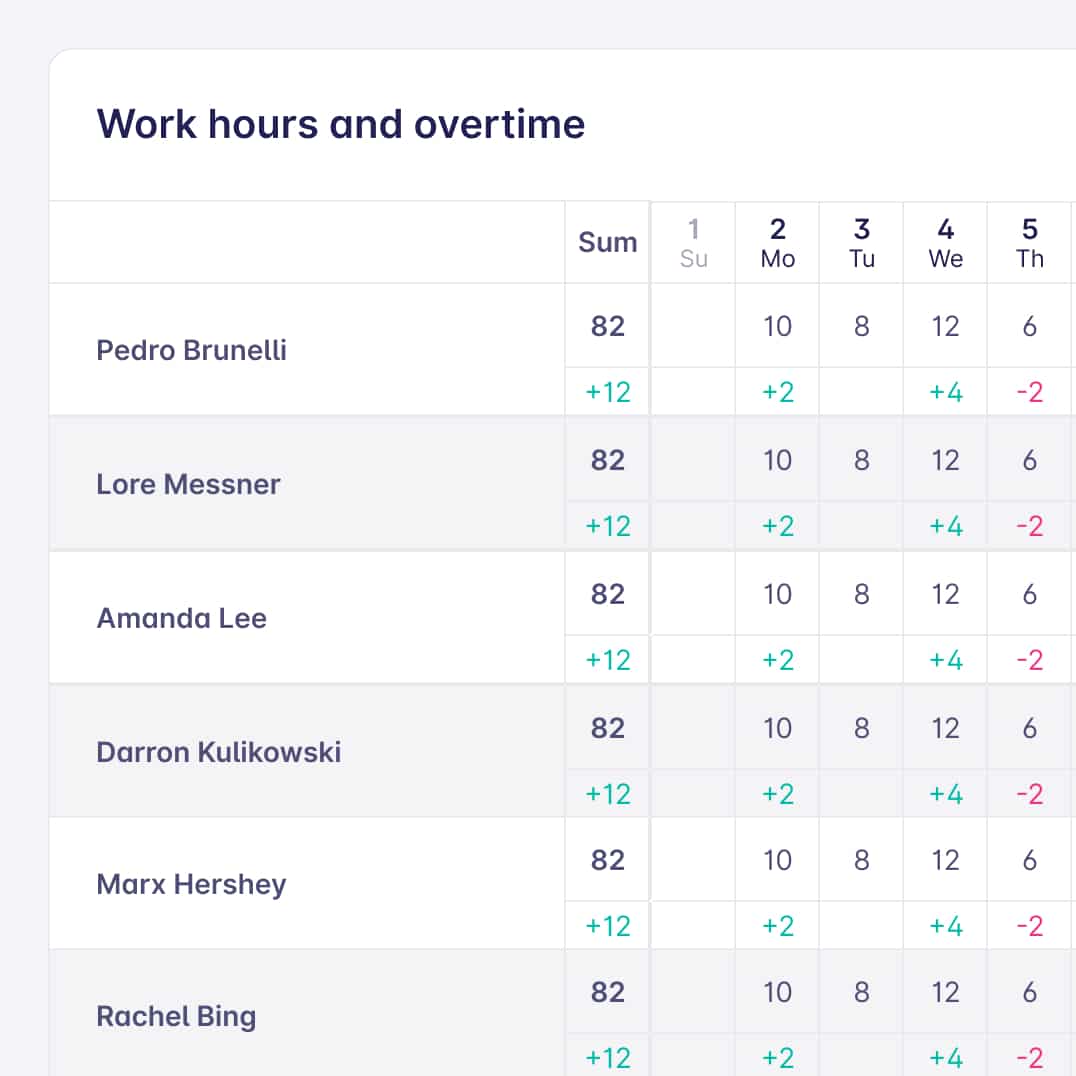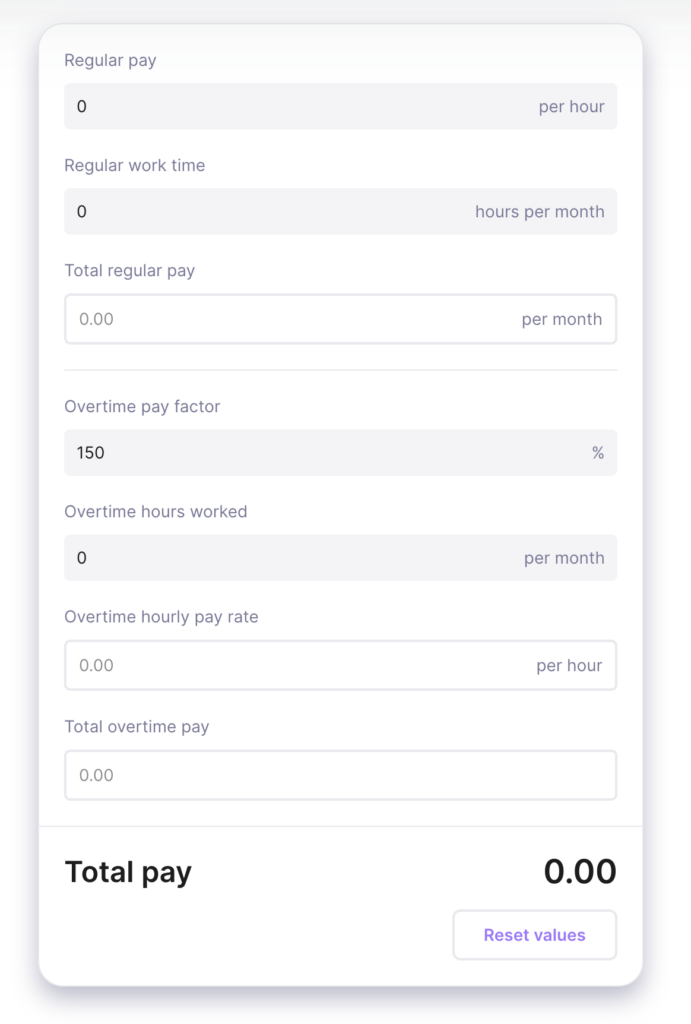To calculate overtime pay and determine how much overtime pay you should receive this month, add relevant details regarding:
- your regular hourly pay rate
- the number of regular hours worked per month
- the overtime pay factor
- the number of hours worked overtime
#1 overtime calculator used by small and big brands

Regular pay
Provide information about your hourly rate during regular work time.

Regular work time
Provide information about the regular hours you worked per month.

Overtime hours worked
Determine the number of hours worked overtime per month.

Overtime pay factor
Also known as overtime multiplier. The overtime multiplier is the rate at which overtime work is paid. It can be equal to the normal rate (100%) or a half rate (50%). However, it’s typically higher than the regular hourly wage, such as time and a half (150%) or double pay (200%). The overtime pay factor is based on the overtime requirements regulated by the federal overtime laws. In this field, determine your overtime multiplier, using percentages.

Total regular pay
Your regular wages are calculated automatically.

Overtime hourly pay rate
The overtime pay rate (per hour) is calculated automatically.

Total overtime pay
Total pay for overtime hours is calculated automatically.
Additional tips:
- To calculate overtime correctly, ensure to add either gross or net amounts.
- Although the Overtime Calculator is preset for calculating monthly overtime pay, you can still use it for calculating overtime weekly pay. In this case, just insert weekly or semi-monthly figures.
Navigating the complexities of overtime pay can feel like strolling through a maze of regulations. Whether you’re a business owner or a team manager, ensuring you comply with the rules while fairly compensating your employees can feel daunting.
In this guide, we’ll show you how to calculate overtime pay, providing a clear and comprehensive roadmap to deal with this crucial aspect confidently. Also, you’ll learn how time tracking can help companies keep overtime track accurately.
What is overtime pay?
According to the Fair Labor Standards Act (FSLA), overtime pay refers to the additional compensation eligible employees receive when working more than their defined number of working hours.
If the average work week of an employee is 40 hours and he works 50 hours, he could be eligible to earn overtime pay for the extra hours he has worked.
The rates, eligibility, and calculation method may vary depending on the labor laws and regulations of the jurisdiction.
What is the FLSA regular rate of pay?
The FLSA regular pay rate is derived by dividing the employee’s total earnings for a given workweek – excluding specific statutory exclusions – by the actual number of hours worked that week.
How does overtime work?
Overtime hours are typically calculated within a workweek framework established by labor laws such as the FLSA. If an employee surpasses the standard weekly hours defined by the FLSA, he becomes eligible for overtime pay.
It’s important to note that the specific rules for overtime pay can vary based on jurisdiction and employment agreements.
Some states may have different overtime thresholds or rates, and certain industries may have unique regulations.
It may also vary depending on the employee classification. The FLSA provides guidelines for proper employee classification, as failing to do so can result in costly penalties retroactively applicable from the employee’s hiring date.
Employees exempt from overtime
As mentioned before, depending on the employee classification, he could be eligible or not for overtime pay.
According to the FLSA, employees who are exempt from overtime pay are not entitled to additional compensation for working more hours than the standard weekly hours because of their job duties and salary levels.
According to the FLSA, exempt categories often include:
- Salaried employees, who receive a fixed salary regardless of their working hours;
- Highly compensated employees;
- Certain professionals, such as doctors, lawyers, and teachers;
- Outside salespeople;
- Some computer professionals who meet specific criteria;
- Some agricultural and farm workers.
How to calculate overtime pay for hourly employees
Calculating overtime pay for hourly employees is a simple task to do. If you work overtime occasionally, use our free Overtime Calculator. To track overtime regularly, use Timeular’s Overtime Tracker that calculates overtime automatically.
To do it manually, multiply the number of overtime hours by the calculated overtime rate, which is usually 1.5 times the regular hourly wage.
This will give you the additional amount the employee should receive for their overtime work. So, it is the number of overtime hours x overtime rate.
Example:
If an hourly employee’s regular hourly wage is $15 and he worked 45 hours in a week, with 5 of those hours being overtime, the calculation would be:
- Regular Pay (40 hours × $15) = $600
- Overtime Pay (5 hours × $15 × 1.5) = $112.50
- Total Earnings = $600 + $112.50 = $712.50
Calculating overtime for multiple pay rates
Calculating overtime for multiple pay rates is more complex than the hourly employees and involves adding up all the hours the employee has worked at each rate. Then, you determine the total pay for each rate by multiplying the hours worked by that rate.
After adding up all these payments, you divide by the total hours worked to find the average rate. If the total hours worked in a week exceed the usual threshold (usually 40 hours), the extra hours qualify for higher overtime pay, one and a half times the average rate.
Finally, you add this overtime pay to the regular pay to get the employee’s weekly earnings.
The overtime pay formula
Total Earnings = (Regular Pay for Rate 1 + Regular Pay for Rate 2 + …) + (Overtime Hours × Weighted Average Rate × 1.5)
Example:
An employee worked 20 hours at $10 per hour and 25 hours at $15 per hour in a 40-hour week:
- Total Regular Pay = ($200 + $375) = $575.
- Weighted Average Rate = Total Regular Pay ÷ Total Hours (45) = $575 ÷ 45 = $12.78.
- Overtime Pay = Overtime Hours × Weighted Average Rate × 1.5 = 5 × $12.78 × 1.5 = $95.85.
- Total Earnings = $575 (Regular Pay) + $95.85 (Overtime Pay) = $670.85.
Overtime pay calculation for nonexempt employees earning a salary
Although nonexempt employees receive a fixed salary, they are entitled to additional pay if their weekly working hours exceed a certain threshold, usually 40 hours.
To calculate their overtime pay, it is necessary to establish their regular hourly rate by dividing their weekly salary by the expected number of hours in a week. When employees work overtime, their pay rate is 1.5 times their regular hourly rate.
Example:
If a nonexempt salaried employee earns $600 per week and he works 45 hours in a week with 5 hours of overtime, the calculation would be:
- Regular Weekly Salary: $600
- Regular Hourly Rate: $600 ÷ 40 hours = $15 per hour
- Overtime Pay Rate: $15 × 1.5 = $22.50 per hour
- Overtime Pay: 5 hours × $22.50 = $112.50
- Total Earnings: $600 + $112.50 = $712.50
Calculating overtime for a nonexempt employee who works a fluctuating workweek
Calculating overtime for a nonexempt employee working a fluctuating workweek addresses a unique scenario where weekly working hours vary weekly. This approach acknowledges the reality that some jobs don’t adhere to fixed schedules.
When overtime hours come into play, the calculation method involves a distinct approach, factoring in half the regular rate as the additional compensation for each overtime hour worked.
Here’s how to calculate overtime pay in such cases:
- If a nonexempt employee’s weekly salary is $500 and he worked 35 hours in a week, his regular rate would be $500 ÷ 35 hours = $14.29 per hour.
- If he worked an additional 10 hours of overtime, his overtime pay would be 10 hours × ($14.29 ÷ 2) = $71.45.
- The total earnings for that fluctuating workweek would be $500 (regular salary) + $71.45 (overtime pay) = $571.45.
Read also: How to effectively create a schedule for employees
Calculating overtime pay for non-hourly compensation
There are other types of compensation rather than those based on an hourly or salary basis that must also be considered when calculating overtime, such as the following.
Piece-rate work
Piece-rate work is a kind of compensation often used in which employees are paid based on the number of pieces or units they produce rather than receiving a fixed hourly wage. Each piece or task has an assigned rate, and the employee will receive money based on productivity.
It is an often-used method in industries where work can be easily measured and quantified, such as manufacturing, agriculture, construction, and certain types of service work.
First, determine the total earnings for the week based on the piece-rate system. Next, calculate the regular rate by dividing the total earnings by the total hours worked, encompassing both piece-rate earnings and hours worked.
Identify any overtime hours beyond the standard threshold, and compute overtime pay by multiplying the overtime hours by half of the regular rate.
Example:
An employee works 45 hours during the week and assembles 150 components, earning $300.
- Regular rate = Total earnings / Total hours worked = $300 / 45 hours = $6.67/hour
- Overtime hours = Total hours worked – Overtime threshold = 45 hours – 40 hours = 5 hours
- Overtime pay = Overtime hours × (Regular rate ÷ 2) = 5 hours × ($6.67 ÷ 2) = $16.67
- Total compensation = Total piece-rate earnings + Overtime pay = $300 + $16.67 = $316.67
Non-discretionary bonuses and commission payments
Non-discretionary bonuses and commission payments are additional compensation that employees can earn based on specific criteria or performance metrics, often outlined in employment contracts or agreements.
The calculation method of non-discretionary bonuses varies depending on where the commission is allocated, by the workweek or monthly, quarterly, or annually.
Overtime rules and regulations
Overtime rules and regulations are the established labor laws that determine how nonexempt employees are compensated for working beyond standard work hours.
The standard overtime pay rate defined by the FLSA is 1.5 times the regular hourly rate on a 40 hours workweek.
Keeping proper records for overtime pay
Keeping proper records for overtime pay is crucial to ensure accurate compensation and compliance with labor laws.
For employers, it is essential to keep an accurate time tracking of the worked hours and a clear and easily accessible record of overtime pay, work hours, and compensation, as well as for employees who work by the hour and need an accurate record of payable hours.
There are several time tracking tools that, through time tracking, help enhance accuracy, streamline processes, and provide a reliable audit trail of worked and overworked hours to facilitate the calculation of overtime pay.
Benefits of time tracking when calculating overtime pay
What is time tracking?
Time tracking refers to recording and monitoring the time spent on various tasks, activities, or projects. It’s a systematic way of tracking how you allocate your time throughout the day. Time tracking can be used for personal productivity, project management, billing clients, or gaining insights into how you manage your time.
Time tracking can involve various methods, including:
- Manual recording: this involves manually noting down the start and end times of tasks or activities. This can be done using a notebook, spreadsheet, or specialized time tracking software.
- Clock-in/out systems: many businesses use clock-in and clock-out systems to track employee work hours. These systems often use biometric authentication, key cards, or digital logins to record when employees start and stop working.
- Time tracking software: there are numerous digital tools and software applications designed for time tracking. These tools often offer features like creating tasks, setting timers, categorizing activities, and generating reports.
Read also: The different types of project reports
Creating a work-record
With time tracking, every time entry from employees is automatically aggregated and ready for invoice whenever you need it. Employers can improve workflows and estimate budgets better. Besides, it generates complete reporting for company audits and more.
Accurate billable hours
As mentioned, time tracking is essential if you bill your clients by the hour because it ensures that the time spent on the task is accurately tracked. There are no overcharging or missing billable hours, and all the little things in between are tracked.
Precise data and reporting
You get valuable insights and automated reports to identify areas you can improve and how much time employees spend on tasks.
Read also: How to reduce overtime
Who is eligible for overtime pay?
Employees who are paid by the hour and don’t have special job duties that exempt them are usually entitled to overtime. According to the Fair Labor Standards Act (FLSA), nonexempt, covered employees are entitled to overtime compensation for hours worked over 40 in a workweek.
What is the overtime formula?
Overtime pay is calculated by multiplying the employee’s regular hourly wage by 1.5 (or another specified multiplier) and then multiplying that result by the number of overtime hours worked. Nonexempt employees receive overtime pay based on this calculation. In our overtime calculator, the overtime multiplier is expressed in %.
What is the overtime formula?
Overtime pay is calculated by multiplying the employee’s regular hourly wage by 1.5 (or another specified multiplier) and then multiplying that result by the number of overtime hours worked. Nonexempt employees receive overtime pay based on this calculation. In our overtime calculator, the overtime multiplier is expressed in %.
Is overtime 1.5 or 2x?
Overtime pay is typically calculated at 1.5 times the employee’s regular pay rate. This means that for each hour worked beyond the standard workweek (usually 40 hours), eligible employees are entitled to receive their regular pay plus an additional of their regular pay rate as overtime compensation.
How do you calculate overtime per day?
In areas where overtime is calculated daily, employers are required to use the applicable overtime rate for every hour exceeding the designated standard workday.
Is overtime calculated by day or week?
Overtime hours are typically calculated every week. In this context, overtime is determined by the number of hours an employee works in a 40-hour workweek.
However, it’s important to note that overtime calculation methods vary by region and industry. Some states may have provisions for daily overtime or other variations.
How to calculate overtime tax?
Overtime pay is generally subject to the same income tax rules as regular pay. Calculating overtime tax involves determining the extra taxes you might owe on the additional income you earn from working overtime.
What is an acceptable overtime percentage?
An acceptable overtime percentage varies depending on the industry, the laws, and the regulations. Usually, keeping overtime within 5-10% of total hours worked is a reasonable goal for maintaining productivity and work-life balance.
How to calculate overtime during a holiday week?
To calculate overtime during a holiday week, you should consider both the extra hours worked and any applicable holiday pay rates to adjust the usual formula to calculate your overtime hours.
How to calculate double overtime?
Calculating double overtime involves determining the extra pay owed to an employee who works more than a certain number of hours beyond their regular work hours, typically over the standard workweek and the initial overtime threshold.
Double overtime pay = (double overtime hours) × (double overtime rate)
How to calculate overtime when there is a holiday?
To calculate overtime during a holiday, you should consider both the extra hours worked and if there’s any special holiday pay rate.
How do you calculate overtime with night differential?
To calculate overtime with night differential, you should consider both the extra hours worked and applicable night shift differential pay rates and overtime rates.






